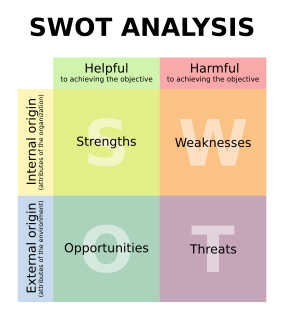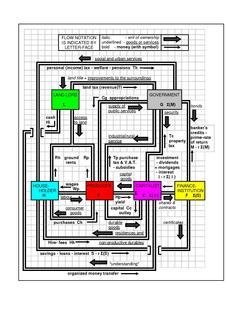Related Research Articles

An ecosystem is a community of living organisms in conjunction with the nonliving components of their environment, interacting as a system. These biotic and abiotic components are linked together through nutrient cycles and energy flows. Energy enters the system through photosynthesis and is incorporated into plant tissue. By feeding on plants and on one another, animals play an important role in the movement of matter and energy through the system. They also influence the quantity of plant and microbial biomass present. By breaking down dead organic matter, decomposers release carbon back to the atmosphere and facilitate nutrient cycling by converting nutrients stored in dead biomass back to a form that can be readily used by plants and other microbes.
In economics, factors of production, resources, or inputs are what is used in the production process to produce output—that is, finished goods and services. The utilized amounts of the various inputs determine the quantity of output according to the relationship called the production function. There are three basic resources or factors of production: land, labour and capital. The factors are also frequently labeled "producer goods or services" to distinguish them from the goods or services purchased by consumers, which are frequently labeled "consumer goods".
Human resources is the set of the people who make up the workforce of an organization, business sector, industry, or economy. A narrower concept is human capital, the knowledge which the individuals embody. Similar terms include manpower, labor, personnel, associates or simply people.
Marketing management is the organizational discipline which focuses on the practical application of marketing orientation, techniques and methods inside enterprises and organizations and on the management of a firm's marketing resources and activities.

Porter's Five Forces Framework is a method for analysing competition of a business. It draws from industrial organization (IO) economics to derive five forces that determine the competitive intensity and, therefore, the attractiveness of an industry in terms of its profitability. An "unattractive" industry is one in which the effect of these five forces reduces overall profitability. The most unattractive industry would be one approaching "pure competition", in which available profits for all firms are driven to normal profit levels. The five-forces perspective is associated with its originator, Michael E. Porter of Harvard University. This framework was first published in Harvard Business Review in 1979.

SWOT analysis is a strategic planning technique used to help a person or organization identify strengths, weaknesses, opportunities, and threats related to business competition or project planning.
Liebig law of the minimum, often simply called Liebig's law or the law of the minimum, is a principle developed in agricultural science by Carl Sprengel (1840) and later popularized by Justus von Liebig. It states that growth is dictated not by total resources available, but by the scarcest resource. The law has also been applied to biological populations and ecosystem models for factors such as sunlight or mineral nutrients.

An economic system, or economic order, is a system of production, resource allocation and distribution of goods and services within a society or a given geographic area. It includes the combination of the various institutions, agencies, entities, decision-making processes and patterns of consumption that comprise the economic structure of a given community.

The Ministry of Finance and Revenue or Ministry of Finance is a ministry of the Government of Pakistan tasked to ensure a strong Pakistani economy by developing policies of sound economic management and providing expert advice to the government.

Environmental resource management is the management of the interaction and impact of human societies on the environment. It is not, as the phrase might suggest, the management of the environment itself. Environmental resources management aims to ensure that ecosystem services are protected and maintained for future human generations, and also maintain ecosystem integrity through considering ethical, economic, and scientific (ecological) variables. Environmental resource management tries to identify factors affected by conflicts that rise between meeting needs and protecting resources. It is thus linked to environmental protection, sustainability, integrated landscape management, natural resource management, fisheries management, forest management, and wildlife management, and others.
Cultural determinism is the belief that the culture in which we are raised determines who we are at emotional and behavioral levels. It contrasts with genetic determinism, the theory that biologically inherited traits and the environmental influences that affect those traits dominate who we are.

Malthusianism is a controversial economic theory that sees fluctuations in human population as reasons for fluctuations in prices. Its general idea is that population growth is potentially exponential while the growth of the food supply or other resources is linear, which eventually reduces living standards to the point of triggering a population die off.
International business refers to the trade of goods, services, technology, capital and/or knowledge across national borders and at a global or transnational scale.
Mineral resource classification is the classification of mineral resources based on an increasing level of geological knowledge and confidence. In an effort to achieve a standard set the classifications, representative bodies from Australia, Canada, South Africa, the USA and the UK reached a provisional agreement in 1997 on the definitions of each of the various mineral classifications. This was followed in 1998 to have these definitions incorporated into the International Framework Classification for Reserves and Resources - Solid Fuels and Mineral Commodities, developed by the United Nations Economic Commission for Europe(UN-ECE).

The National Command Authority,, is the apex civilian led command to oversee the employment, policy formulation, exercises, deployment, research and development, and operational command and control of Pakistan's nuclear arsenals.
Comparative Economic Systems is the sub-field of economics dealing with the comparative study of different systems of economic organization, such as capitalism, socialism, feudalism and the mixed economy. It is widely held have been founded by the economist Calvin Bryce Hoover. Comparative economics therefore consisted mainly of comparative economic systems analysis before 1989 but substantially switched its efforts to comparison of the economic effects of the transition experience from socialism to capitalism. It is a part of economics which is the study of gaining knowledge concerned with the production, consumption and transfer of wealth. It is based on the collective wants of the population and the resources available that initially create an economic system. The performance of the economic system can be measured through gross domestic product (GDP); that is, it will indicate the growth rate of country. Normative judgments can be made as well by asking questions like whether the gap of the distribution of wealth and income and social justice. Theoreticians regularly try to evaluate both the positive and normative aspects of the economic system in general and they do so by making assumptions about the rules of the game governing utility-seeking. It is comparatively easy to predict the economic outcomes when the economic system of the country has either a perfect competition or has a perfect planning economic system. With those types of the economic systems, it is easy to offer policy guidance.
For the application of engineering economics in the practice of civil engineering see Engineering economics.
Profit, in accounting, is an income distributed to the owner in a profitable market production process (business). Profit is a measure of profitability which is the owner's major interest in the income-formation process of market production. There are several profit measures in common use.
Peak minerals marks the point in time when the largest production of a mineral will occur in an area, with production declining in subsequent years. While most mineral resources will not be exhausted in the near future, global extraction and production is becoming more challenging. Miners have found ways over time to extract deeper and lower grade ores with lower production costs. More than anything else, declining average ore grades are indicative of ongoing technological shifts that have enabled inclusion of more 'complex' processing – in social and environmental terms as well as economic – and structural changes in the minerals exploration industry and these have been accompanied by significant increases in identified Mineral Reserves.
References
- ↑ Economic forces, Business Dictionary
- ↑ Economic Forces, Investor Words
- ↑ Economic Forces, Connexions